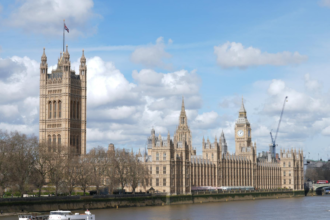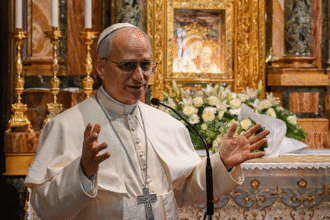Many residents in and around the Italian city of Naples spent the night on the streets and in their cars after a powerful earthquake struck, shaking buildings and causing rubble to crash down.
Italian seismologists reported that the 4.4 magnitude tremor struck at 01:25 local time on Thursday at a shallow depth of 3km (two miles), with its epicenter located on the coast between Pozzuoli and Bagnoli.
The Naples earthquake was widely felt across Naples, causing disruptions to power supplies in some parts of the city. Residents described the experience as terrifying, with buildings swaying and objects falling from shelves. Some reported hearing a loud rumble before feeling the violent shaking, which lasted for several seconds.
Was This Earthquake Linked to Mount Vesuvius?
Despite concerns, Italy’s National Institute of Geophysics and Volcanology (INGV) stated that there was “no evidence” that the tremor was an indication of an imminent eruption of Mount Vesuvius.
However, experts continue to monitor the situation closely due to the region’s seismic activity. The Campi Flegrei area, where the Naples earthquake occurred, is known for its history of volcanic activity. Scientists have long warned that the region remains geologically active and could pose a significant risk in the future.
Dr. Marco Rossi, a geologist specializing in volcanic activity, explained, “While this earthquake does not indicate an immediate eruption, the continuous movement of the earth is something we must watch carefully. Even minor tremors can weaken structures and increase the likelihood of future seismic events.”
Were There Any Casualties or Damage?
In Bagnoli, near the epicenter, a woman was pulled from the rubble of a partially collapsed house, suffering only light injuries.
The Naples earthquake caused structural damage in various parts of the city. The bell tower of a local church sustained damage, and several cars had their windscreens smashed. Cracks appeared in some buildings, leading to concerns about their stability.
In Pozzuoli, residents expressed growing concern about the increasing frequency of tremors. One resident told Italian television: “We fear this is a different phenomenon from what has happened in the past. We are seeing more frequent and stronger quakes than before. It makes us anxious about what might come next.”
Residents have reported hearing unsettling noises underground, and some have noticed unusual ground movements in the past few months. These signs have only heightened fears about a potential larger seismic event.
How Did Residents React?
The Naples earthquake sent panic through Naples and surrounding areas, prompting people to evacuate their homes and gather on the streets, fearing more tremors. Many stayed outside for hours, unwilling to return indoors until they felt it was safe.
“We were sleeping when suddenly everything started shaking,” said Antonio De Luca, a resident of Naples. “My family and I ran outside in our pajamas. We are afraid to go back inside because aftershocks keep happening.”
The quake was followed by as many as six aftershocks, adding to residents’ anxiety. Some aftershocks were mild, but others were strong enough to be felt across several districts of Naples. This ongoing activity has left many locals on edge.
Along the coast, the mayor of Bacoli, Josi Gerardo Della Ragione, described the night as “difficult” but confirmed that his town had not suffered damage. However, he emphasized the importance of preparedness and urged residents to remain vigilant.
How Are Authorities Responding?
Italian Prime Minister Giorgia Meloni remained in close contact with officials and was closely monitoring the situation, government sources said. Emergency response teams were deployed to assess damage and assist affected residents.
Authorities took precautionary measures, including closing schools on Thursday to allow structural inspections to be carried out and ensure building stability. Engineers and safety inspectors have been dispatched to examine older buildings that might have been weakened by the tremor.
Local officials have set up temporary shelters for those too afraid to return home. Emergency hotlines have been activated to assist residents in distress and provide guidance on safety protocols.
Why Is the Campi Flegrei Area Prone to Earthquakes?
Naples sits atop the Campi Flegrei (Phlegraean Fields), a vast volcanic basin that has experienced seismic activity for thousands of years. The area is classified as a supervolcano, meaning its eruptions can be catastrophic. The last significant eruption occurred nearly 40,000 years ago, but the region has remained active ever since.
The region is home to over 800,000 people, making it one of the most densely populated volcanic areas in the world. Scientists have noted an increase in seismic activity over the past few years, with smaller tremors becoming more frequent.
Professor Lucia Moretti, a geophysicist, explained, “The Campi Flegrei caldera is one of the most complex volcanic systems in the world. Even when there is no eruption, the ground movements indicate that magma is shifting beneath the surface.”
Is There a Growing Concern About Bradyseism?
Local officials are particularly concerned about the increasing speed of “bradyseism,” a geological phenomenon that causes the ground to rise and fall. This phenomenon has been recorded in the region for centuries, but recent measurements suggest it is accelerating.
Francesca Bianco from INGV highlighted that “the rate of the ground rising has trebled recently, going from 1cm to 3cm per month.” This rapid shift is causing alarm among scientists and local authorities alike.
Bradyseism is particularly dangerous because it can lead to the gradual weakening of structures. Buildings in the region are at risk of cracking or becoming unstable, which could have serious consequences if another earthquake occurs.
Edoardo Cosenza, a civil protection councillor in Naples, warned on social media: “When the speed of bradyseism increases, it is time to respond. We know it, and we need to act accordingly. We must reinforce our structures and ensure people are prepared for potential disasters.”
What Comes Next for Naples?
As authorities continue to assess the situation, residents remain on high alert, bracing for potential further seismic activity in the region. Scientists and emergency planners are urging people to stay informed, prepare emergency kits, and have evacuation plans in place.
“We cannot predict exactly when another earthquake will strike,” said Dr. Rossi. “But we do know that this area is seismically active, and residents must be ready for future events.”
The recent Naples earthquake serves as a stark reminder of the region’s vulnerability. While recovery efforts are underway, the focus remains on long-term preparedness to protect lives and infrastructure against future tremors. The people of Naples, resilient as ever, continue to hope for calm after the latest seismic shock.








